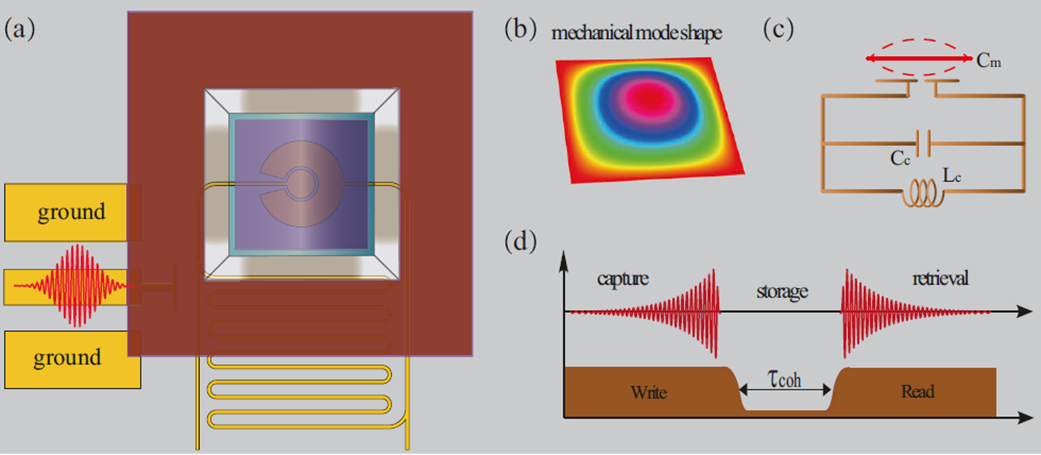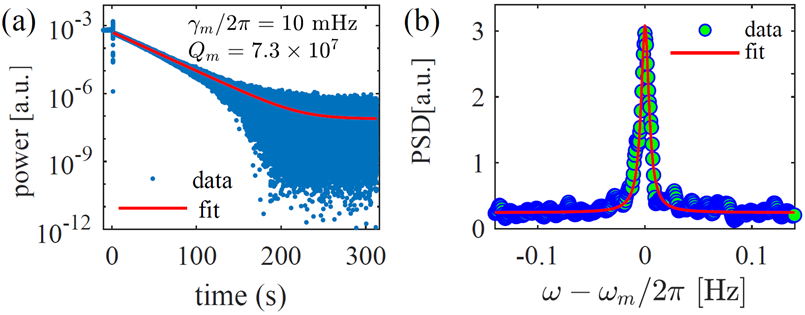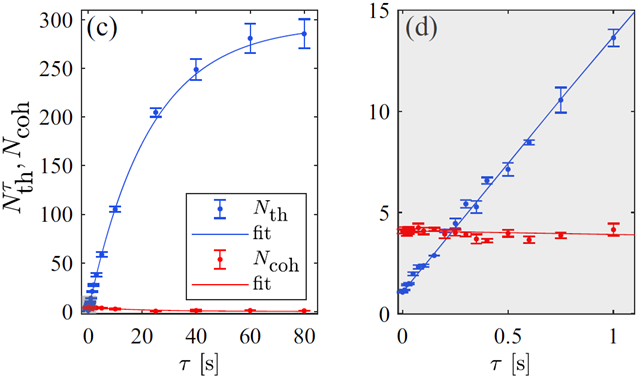The team of Quantum Cloud Platform made progress in long lifetime coherent storage of microwave photons
2023/08/16
Recently, the research teams from the Beijing Academy of Quantum Information Sciences, Beijing Computational Science Research Center, and the School of Integrated Circuits at Tsinghua University found that the high-quality factor acoustic quantum systems have significant potential in the construction of long lifetime microwave coherent memory. This work has enabled on-demand storage and readout of microwave states, setting a new record in storage time for optomechanical coherences. On August 11, 2023, the relevant work was published under the title "Coherent memory for microwave photons based on long-lived mechanical excitations" in npj Quantum Information.
The superconducting cavity optomechanical device configuration
Recent years, manipulating the state of macroscopic mechanical resonators through the radiation pressure of light has become one of the most popular research fields in the world. Based on the physical characteristics of different systems that are coupling each other, the mechanical resonators can be flexibly designed in structure and material selection. Therefore, cavity optomechanical systems possess perspective compatibility and scalability, making them pivotal in many fields of measurement and sensing. Through the sideband transitions assisted by the cavity field, thermal phonons are transported and quickly dissipated, enabling the cooling of mechanical resonators to their quantum ground state. The quantization of mechanical vibrations is also known as phonons. By relying on the quantum acoustic system of mechanical resonators, they can be coupled with various natural or artificial quantum systems, providing an ideal and efficient quantum coherent interface for communication, interconnection, and expansion among different quantum systems. Meanwhile, quantum memory is one of the key modules in quantum information processing and universal quantum network. For example, long lifetime memory can be applied to error-tolerant coding and relays for quantum state long-distance transmission. Cavity optomechanical devices with ultra-long lifetime mechanical modes are ideal candidates for quantum state storage, electronic quantum computing, and coherent interconnection for laser band communications. The manipulation of optical radiation pressure also provides a new technical method for on-demand controllable reading and writing of quantum states.

Fig. 1 Schematic diagram of on-chip superconducting cavity optomechanical device and the pulse sequence. (a) Superconducting cavity optomechanical device is composed of metallized silicon nitride film and Nb film superconducting circuit; (b) membrane vibration shape; (c) schematic diagram of the lumped element model; (d) state storage and pulse sequence of state tomography.
Figure 1(a) shows the structure of the microwave cavity optomechanical device, which is mainly composed of a superconducting microwave circuit resonator with an ouroboros structure and a metallized silicon nitride membrane mechanical resonator. Different from the traditional flip-chip bonding process, a reversed process of first flip-chip bonding and then metallization is adopted here, which optimizes the controls of the vacuum gap size between the membrane and circuit capacitator. The metallized silicon nitride membrane and the coupling capacitance of the bottom circuit of the ouroboros structure form a space capacitance structure. The reversed process proposed by the researchers in this work can further reduce the vacuum gap of the mechanical capacitance and increase the opto-mechanical coupling strength, which is one of the key technologies to achieve its quantum ground state. The mechanical resonator is provided by a highly stressed silicon nitride film, and the finite element simulation of the first-order out-of-plane resonance mode is shown in Fig. 1(b). The lumped parameter model of the device is shown in Fig. 1(c). The vibrating silicon nitride membrane will change the size of the space capacitance, further causing a shift of the in intrinsic frequency of the microwave cavity, forming radiation-pressure coupling in the form of dispersion. Figure 1(d) shows the time-domain sequence of pulse for the microwave state storage and retrieval.
Vibrational Modes and Ground State Cooling
Through the energy relaxation characterization and spectrum analysis of the mechanical resonator, the energy relaxation time of the mechanical resonator is obtained as close to 16 seconds, the corresponding energy spectrum linewidth is as small as 10.2 mHz, and the quality factor of the mechanical oscillator reaches 73 millions, as shown in Fig. 2(a). If microwave signals can be stored in the mechanical resonator by the type of mechanical energy, the energy storage lifetime of microwave photons will represent the highest level in the world at present, which is also one of the ideas for this work to build quantum memories based on mechanical resonators. In order to ensure the phase coherence of the stored microwave state, the researchers also overcome the key technical bottleneck of sideband cooling of low-frequency mechanical vibration, and successfully cooled the mechanical resonator to its ground state, which is a prerequisite for quantum manipulation based on mechanical resonators.

Fig. 2 Characterization of mechanical energy dissipation (a) time-domain ringdown test; (b) energy spectrum analysis.
Quantum state tomography and decoherence evolution
Based on the prepared mechanical quantum ground state, The researchers conducted systematic research on the capture, storage, and retrieval of itinerant microwave photons. In the experiment, the mechanical resonator was first prepared to its ground state by sideband drive with constant intensity. Under the action of the write pulse, the amplitude and phase information of the signal pulse will be mapped to the mechanical storage device (that is the mechanical mode), and then the write pulse is turned off and the writing process is stopped. The written signals will experience energy decoherence as well as quantum decoherence caused by the ambient heat reservoir. A readout pulse will be applied to revive the stored signal if the target microwave pulse signal of interest is required to be further processing.

Fig. 3 Time domain evolution of thermal phonons and coherent microwave photons in mechanical memory
It is worth noting that both the write and read pulses are sideband driving fields of constant amplitude. The sideband driving field plays multiple roles in the experiment, including resonator initialization, writing and reading. In order to improve the writing efficiency of the signal, the signal pulse is modulated into an exponentially rising envelope to resist the optical damping introduced by the writing field. The quantum efficiency of writing is highest when the exponential gain rate of the signal matches the decay rate induced by the write field. After repeating reading and writing thousands of times and projecting the signal in the orthogonal direction, the phase space distribution of the macroscopic quantum state can be obtained. Since thermal noise is random and obeys a Gaussian distribution with an average value of zero, the variance of the phase space distribution represents the number of thermal phonons, and the average value represents the coherent component of the signal. Through the characterization of the time-domain variation of the state distribution, the researchers found that the device can store microwave photons with a decoherence time as high as 55.7 milliseconds, as shown in Fig. 3. Towards coherent storage of quantum states at the single-photon level, follow-up work will require further cooling of mechanical oscillators to a lower number of thermal phonons.

Fig. 4 Summary of coherence lifetimes of various types of cavity optomechanical memory
According to the experimental results, the resonator thermal noise is greatly suppressed when the mechanical resonance mode cools to its quantum ground state. The research on quantum memory based on mechanical resonator has become a hot field at present, and many international research groups are pursuing more extreme device performance. Figure 4 shows the achievement of some international research groups in the coherent storage lifetime of optical fields based on mechanical resonators. Current work realized on-demand storage and reading of microwave states, the energy decoherence time of stored microwave states was nearly 16 seconds, and the quantum decoherence time was 55 milliseconds, creating a new record for optical-mechanical coherent storage time. This technological breakthrough will bring new opportunities for superconducting quantum code storage, interconnection based on microwave photon relay, basic testing of quantum gravity, and even the search for dark matter.
The authors of the paper include Yulong Liu, an associate researcher at the Beijing Academy of Quantum Information Science, Qichun Liu, a senior engineer (contribute equally), Huanying Sun, an assistant researcher, Mo Chen, a senior engineer, Dr. Shuaipeng Wang from the Beijing Computational Science Research Center, and Tiefu Li, from the School of Integrated Circuits, Tsinghua University. This work has been supported by the micro-nano processing platform of our institute, the National Natural Science Foundation of China, the national key research and development project, and the international cooperation project of Beijing International Cooperation Center.
DOI: https://doi.org/10.1038/s41534-023-00749-x
 中文
中文 Email
Email QCloud
QCloud Log in
Log in
